1981 Honda CB650
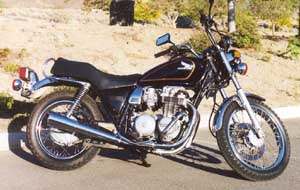
ZX-9R, but the Monster fits the bill nicely. The Kawi is out of my mind now that I've experienced Ducatis.....
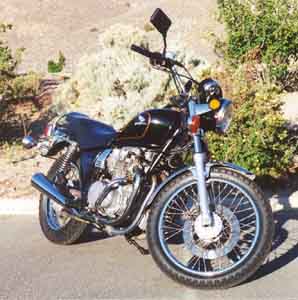
They claimed the charging sytem was working perfectly (I actually never completely ran out of battery juice since that day, but it was not perfect- the electrical problems on these bikes are pretty much incurable), and they found me a used speedometer after some searching.
I also bought a ton of parts. I replaced the air cleaner, changed the oil and filter (which was installed incorrectly so that the oil wasn't being filtered at all), changed the spark plug wires, changed the clutch and brake levers, had the forks rebuilt, adjusted and lubed the chain, adjusted the clutch, changed the master cylinder reservoir, bled the brakes, cleaned the spark plugs, replaced the speedometer cable, lubed all the other cables, added mirrors, charged the battery several times, and learned to ride pretty well.
After not being able to get the bike past 50MPH, I disassembled the carbs and cleaned the gunk out of them. There was a bit of sludge and rusty water floating around inside. It kind of helped, but the bike still experienced an ignition misfire and burned oil badly. Cheap rebuild parts were out of the question with this bike.
The bike was a blast (although there was still some engine problems to address, namely wear), and with insurance, tax, title, registration, parts, and gear (very expensive), I had less invested than I would have in a crummy used car. Not bad, not bad at all.
If you're looking to buy a good used bike, I would suggest keeping your eyes peeled at the local dealerships (except Reno Kawasaki if you're in Reno- they are the biggest bunch of A-Holes I've ever had the displeasure of meeting). Big Valley Honda, where I bought both my bikes, has been very helpful and very cool. I got 20% off gear, and they have been more than willing to see to it that I am satisfied with my purchases. I must have been in there at least 30 times since I bought my bikes, and they never give me an attitude like I'm bugging them or anything. They've tracked down parts for me and were very quick to have me bring the CB in so they could take a look at it when I was having the elctrical problems. Overall, I have been extremely satisfied with them. There is no way in heck that I could have gotten the same help from a private party- they would have laughed right in my face.
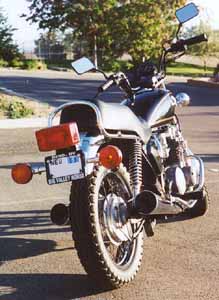
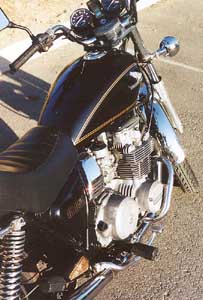
As far as the electrical problems on CB650's, I never figured out a way around that. After countless hours of searching for info (of which there is very little), the most likely cause seems to be that the stator (rotor) in the alternator shorts out when it gets hot. Most people complain of riding for several miles, and their voltage begins to drop until the bike finally dies. The battery will get charged up, and it will do it all over again. This theory of a rotor short seems pretty likely, as my bike ran fine cold, but once hot it gave me hell. I didn't run into a slowly draining battery, but I'm sure I would have. To fix it, I've heard of some people soldering the wires directly together instead of the connectors (take out the harness and match the wires up), because this will get rid of the corrosion in the connector that supposedly causes the short. Seems like a 50/50 shot to me, because I had zero corrosion in my connector and I still had problems. It's possible to get a new rotor, but it's in the neighboorhood of $160, and there is no guarantee that it won't short out again. My advice- find a new bike or swap motors. It's not that I didn't like my CB, it's just that I know when to quit.
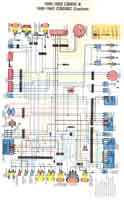
These are just a few tips about working on an older bike, but specifically on a CB650:
1. There will be problems. No matter what a sweet deal you may think you've gotten, the fact remains that the parts are several decades old and are at least somewhat deteriorated. As far as parts to watch out for, here are the main ones:
The tires should definitely be replaced if showing any signs of wear or dryrot
The battery too
All fluids should be changed (oil, transmission oil if applicable, brake fluid).
The fuel tank should be cleaned of all gunk and de-rusted (products such as POR-15 are easy to use and fairly inexpensive).
Any deteriorated wiring should be replaced, or at least re-wrapped to avoid a short
2. A complete tune-up should be performed. There is way too much stuff to list here, but this includes the obvious stuff like changing the air filter and oil, to the little stuff like checking ohm resistance in the wiring. Some of the stuff requires access to several fancy tools, but it's worth it if you can track down a problem that would otherwise not be evident. On my CB650, that included cleaning and greasing all electrical connections (with an electrical grease- regular grease doesn't conduct electricity), checking the timing AND the advanced timing (outlined in the manual), checking for spark at each plug, following all wiring and checking for exposed wires (found a couple and re-wrapped in electrical tape), inspecting all vent hoses and tubes (of which there are a jillion) for cracks and correct hookups, inspecting for obstructions in the intake path, tightening all bolts to the reccomended spec, draining the blow-by vent tube, cleaning the gunk out of the float bowls of the carbs, and all the other tune-up stuff. It may seem like a total hassle, but if broken up into several days it shouldn't be too bad. Once it's running smooth, it will be well worth it. Don't forget a visual inspection before each ride!
3. Don't overtighten the oil drain plug or the oil filter bolt- simply snug them up pretty good (don't crank in other words) until they don't leak or use a torque wrench to get it exactly right.
4. When diagnosing problems, start with the simple stuff first. Don't believe that bad gas can cause the bike to surge and buck violently? Well, it can happen. You need to ask yourself what the bike needs in order to run- ignition, fuel, and air. Check to see that the bike is getting all three of those.
---For riding tips, see my Cycle Instructions page---